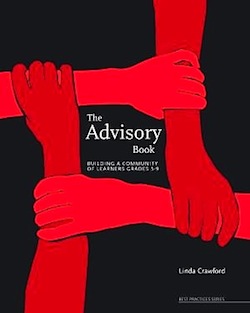A Wonderful Advisory Resource
The Advisory Book: Building a Community of Learners (2nd Edition)
by Linda Crawford
(The Origins Program, 2012 – Learn more)
Reading this new edition of The Advisory Book: Building a Community of Learners Grades 5-9 reminded me just how much I have used the first edition over the past few years. The second edition has five parts: (1) an argument for advisory; (2) an explanation of a structure called the Circle of Power and Respect; (3) an explanation of the shorter-form Activity Plus Advisory; (4) factors to consider when planning advisory; and (5) a huge selection of sample themes and activities for Advisory.
The author, Linda Crawford, founded The Origins Program, a group that supports the Responsive Classroom program for elementary schools and offers its own Developmental Designs program for middle level schools.

there is a set of personal and social skills that students need to learn and practice in order to be successful socially and academically: cooperation, communication, assertion, responsibility, engagement, empathy, self-control. (p. 19)
The functions of Advisory, according to the book, are to teach these skills, make learning meaningful, establish a climate of trust, and prepare students to learn.
Delving deeper into the book
The second and third chapters of The Advisory Book describe two basic formats for Advisory. The Circle of Power and Respect is a longer format, and the Activity Plus Advisory is a shorter format. Both formats include a greeting (assuming that Advisory begins the school day) as well as an activity that may be more or less elaborate. Teachers who do not have an Advisory program in their schools could adapt some of the ideas of these formats to a regular academic class period.
The fourth chapter corrals segments from the fifth chapter under several headings: Advisory with an academic focus, Advisory with a personal focus, and so forth. This chapter gives teachers a way to think of separate Advisory activities in a progressive sequence.
The fifth chapter is the heart of the book, because it includes more than one hundred pages of thematic ideas and plans for Advisory. The six units are: getting acquainted, health and well-being, adolescent needs, multicultural understanding, societal issues, and witnessing bullying. (Of these, only the last unit is new for the second edition.)
My enthusiastic endorsement
I recommend this book enthusiastically for middle level teachers and school leaders. If your school does not have Advisory and you are interested and invested in helping students develop their social-emotional skills, this book is a wonderful resource for specific activities as well as the research that supports Advisory.
Being an Advisor was one of my favorite roles. My former school adopted the Developmental Designs program some years ago, and I loved it. The first edition of The Advisory Book helped our planning and gave structure to what had been a hit-and-miss part of the schedule in previous years. At the end of the week, I would often spend time looking through this book and building my plans for Advisory for the next week. Even more, I started to adapt some of the activities in this book into my content areas as good instructional strategy. Students generally were very responsive and enjoyed learning content in an engaging and interactive way.
The second edition does not offer too many additions to the first edition, and there are not that many changes to the content. If you have the first edition, you may want to stick with that. If you do not, by all means—add this book to your personal or professional library.
Also see Amanda Wall’s article “Belonging in the Middle Grades.”
Amanda Wall is an assistant professor in the Department of Teaching and Learning at Georgia Southern University, where she teaches courses in the middle grades program. She taught Language Arts and Latin in grades 5-12 for many years. Her articles for MiddleWeb can be found here.




































